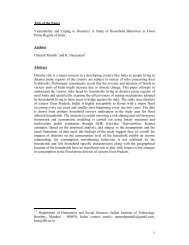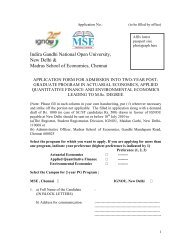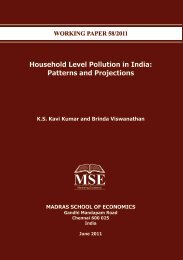Discount Rate for Health Benefits and the Value of Life in India
Discount Rate for Health Benefits and the Value of Life in India
Discount Rate for Health Benefits and the Value of Life in India
Create successful ePaper yourself
Turn your PDF publications into a flip-book with our unique Google optimized e-Paper software.
WORKING PAPER 60/2011<br />
<strong>Discount</strong> <strong>Rate</strong> <strong>for</strong> <strong>Health</strong> <strong>Benefits</strong> <strong>and</strong><br />
<strong>the</strong> <strong>Value</strong> <strong>of</strong> <strong>Life</strong> <strong>in</strong> <strong>India</strong><br />
K.R. Shanmugam<br />
MADRAS SCHOOL OF ECONOMICS<br />
G<strong>and</strong>hi M<strong>and</strong>apam Road<br />
Chennai 600 025<br />
<strong>India</strong><br />
August 2011
<strong>Discount</strong> <strong>Rate</strong> <strong>for</strong> <strong>Health</strong> <strong>Benefits</strong> <strong>and</strong> <strong>the</strong><br />
<strong>Value</strong> <strong>of</strong> <strong>Life</strong> <strong>in</strong> <strong>India</strong><br />
K.R. Shanmugam<br />
Pr<strong>of</strong>essor, Madras School <strong>of</strong> Economics,<br />
shanmugam@mse.ac.<strong>in</strong><br />
i
WORKING PAPER 60/2010<br />
August 2011<br />
Price : Rs. 35<br />
MADRAS SCHOOL OF ECONOMICS<br />
G<strong>and</strong>hi M<strong>and</strong>apam Road<br />
Chennai 600 025<br />
<strong>India</strong><br />
Phone: 2230 0304/2230 0307/2235 2157<br />
Fax : 2235 4847/2235 2155<br />
Email : <strong>in</strong>fo@mse.ac.<strong>in</strong><br />
Website: www.mse.ac.<strong>in</strong><br />
ii
<strong>Discount</strong> <strong>Rate</strong> <strong>for</strong> <strong>Health</strong> <strong>Benefits</strong> <strong>and</strong> <strong>the</strong><br />
<strong>Value</strong> <strong>of</strong> <strong>Life</strong> <strong>in</strong> <strong>India</strong><br />
K.R. Shanmugam<br />
Abstract<br />
This study contributes to <strong>the</strong> literature by estimat<strong>in</strong>g discount rate <strong>for</strong><br />
environmental health benefits <strong>and</strong> value <strong>of</strong> statistical life <strong>of</strong> workers <strong>in</strong><br />
<strong>India</strong>. The discount rate is imputed from wage-risk trade-<strong>of</strong>fs <strong>in</strong> which<br />
workers decide whe<strong>the</strong>r to accept a risky job with higher wages. The<br />
estimated real discount rate ranges between 2.7 <strong>and</strong> 3 percent, which is<br />
closer to <strong>the</strong> f<strong>in</strong>ancial market rate <strong>for</strong> <strong>the</strong> study period <strong>and</strong> consistent<br />
with earlier studies from developed nations. The estimated value <strong>of</strong> life is<br />
Rs. 20 (US $ 1.107) million. The results <strong>of</strong> <strong>the</strong> study can aid<br />
policymakers, <strong>in</strong>ternational agencies <strong>and</strong> o<strong>the</strong>r researchers <strong>in</strong> evaluat<strong>in</strong>g<br />
health projects <strong>in</strong> <strong>India</strong> <strong>and</strong> o<strong>the</strong>r develop<strong>in</strong>g countries.<br />
Keywords: Expected length <strong>of</strong> life, value <strong>of</strong> statistical life, time<br />
preference rate<br />
JEL Codes: J17, J28, <strong>and</strong> J31<br />
iii
INTRODUCTION<br />
Economic analyses <strong>of</strong> life sav<strong>in</strong>g policies require appropriate discount rate<br />
<strong>for</strong> compar<strong>in</strong>g long-term health benefits. It is, <strong>in</strong> general, argued that <strong>the</strong><br />
society’s risk less rate <strong>of</strong> time preference can serve as <strong>the</strong> discount rate<br />
<strong>for</strong> all benefit components if capital markets are perfect. The issue<br />
becomes more complex if capital markets are imperfect <strong>and</strong> particularly<br />
<strong>for</strong> health benefits because human health/life can not be traded explicitly<br />
<strong>in</strong> an <strong>in</strong>ter-temporal market (Moore <strong>and</strong> Viscusi, 1990). In this context,<br />
<strong>the</strong> debate is whe<strong>the</strong>r one can use <strong>the</strong> same discount<strong>in</strong>g rate that is used<br />
<strong>for</strong> evaluat<strong>in</strong>g o<strong>the</strong>r benefit components or one can f<strong>in</strong>d a different rate<br />
<strong>for</strong> health benefits.<br />
Many studies have attempted to resolve this issue empirically by<br />
estimat<strong>in</strong>g <strong>the</strong> discount rate <strong>for</strong> health impacts <strong>and</strong> <strong>the</strong>n compared <strong>the</strong><br />
estimated rate with market rate <strong>of</strong> <strong>in</strong>terest <strong>for</strong> trad<strong>in</strong>g f<strong>in</strong>ancial resources<br />
(eg., Atmadja, 2008; Kula, 2004; Van der Pol <strong>and</strong> Cairns, 2001; <strong>and</strong><br />
Viscusi <strong>and</strong> Moore, 1989). These studies are broadly grouped <strong>in</strong> to:<br />
stated preference studies <strong>and</strong> revealed preference studies. In <strong>the</strong><br />
<strong>for</strong>mer, <strong>in</strong>dividuals are asked to evaluate <strong>the</strong> stylized <strong>in</strong>ter temporal<br />
prospects <strong>in</strong>volv<strong>in</strong>g real or hypo<strong>the</strong>tical outcomes such as health <strong>and</strong> life<br />
years, while <strong>in</strong> <strong>the</strong> latter rates are computed from economic decisions<br />
that people make <strong>in</strong> <strong>the</strong>ir ord<strong>in</strong>ary life (see Frederick et al., 2002 <strong>for</strong> an<br />
excellent survey).<br />
Early studies <strong>in</strong> <strong>the</strong> revealed preference category exam<strong>in</strong>ed <strong>the</strong><br />
consumer’s trade-<strong>of</strong>f between <strong>the</strong> immediate purchase price <strong>of</strong> electrical<br />
appliances <strong>and</strong> <strong>the</strong> long-term costs <strong>of</strong> runn<strong>in</strong>g <strong>the</strong>m. Estimated rates <strong>in</strong><br />
<strong>the</strong>se studies vastly exceeded <strong>the</strong> market rates <strong>and</strong> varied widely across<br />
product categories. Ano<strong>the</strong>r set <strong>of</strong> studies, called labor market studies<br />
have estimated <strong>the</strong> discount rates from wage risk trade-<strong>of</strong>fs. They have<br />
used three alternate but equally plausible models: discounted expected<br />
life years (DELY) model (Moore <strong>and</strong> Viscusi, 1988), Markov decision (MD)<br />
1
model (Viscusi <strong>and</strong> Moore, 1989) <strong>and</strong> life cycle (LC) model (Moore <strong>and</strong><br />
Viscusi, 1990). The estimated rates <strong>in</strong> <strong>the</strong>se studies, rang<strong>in</strong>g 2 <strong>and</strong> 17<br />
per cent, have a more plausible range than consumers’ implicit discount<br />
range from 17 to 300 per cent <strong>for</strong> appliance energy efficiency.<br />
Follow<strong>in</strong>g this tradition, this study attempts to estimate <strong>the</strong> value<br />
<strong>of</strong> life <strong>and</strong> <strong>the</strong> implicit time preference rate that <strong>the</strong> <strong>India</strong>n workers reveal<br />
through <strong>the</strong>ir will<strong>in</strong>gness to <strong>in</strong>cur <strong>the</strong> job related fatal risks. It contributes<br />
to <strong>the</strong> discount<strong>in</strong>g literature primarily <strong>in</strong> two ways. Firstly, <strong>the</strong> labor<br />
market studies us<strong>in</strong>g LC model are practically non existent <strong>in</strong> develop<strong>in</strong>g<br />
countries <strong>and</strong> o<strong>the</strong>r developed countries except USA. This is <strong>the</strong> first<br />
study <strong>in</strong> <strong>the</strong> develop<strong>in</strong>g country context utiliz<strong>in</strong>g <strong>the</strong> LC model. Secondly,<br />
<strong>in</strong> <strong>the</strong> <strong>India</strong>n context a few stated preference studies such as Pender<br />
(1996) <strong>and</strong> Atmadja (2008) provide <strong>the</strong> estimates <strong>of</strong> discount rate,<br />
rang<strong>in</strong>g between 10-70 per cent. A few revealed preference studies such<br />
as Kula (2004) <strong>and</strong> Shanmugam (2006) also provide <strong>the</strong> estimates <strong>of</strong><br />
discount rate. This study enables us to check <strong>the</strong> robustness <strong>of</strong> <strong>the</strong><br />
results <strong>of</strong> past studies, particularly Shanmugam (2006) which uses <strong>the</strong><br />
DELY model.<br />
The rest <strong>of</strong> this study proceeds as follows. A brief review <strong>of</strong><br />
literature is given <strong>in</strong> <strong>the</strong> next section. Then we expla<strong>in</strong> <strong>the</strong> methodology,<br />
<strong>the</strong> data <strong>and</strong> variables used <strong>in</strong> <strong>the</strong> study. Empirical results are presented<br />
<strong>and</strong> discussed <strong>in</strong> <strong>the</strong> subsequent section. In <strong>the</strong> f<strong>in</strong>al section, <strong>the</strong> general<br />
conclusions <strong>and</strong> implications <strong>of</strong> <strong>the</strong> study are given.<br />
A BRIEF REVIEW OF LITERATURE<br />
The discount rate is one <strong>of</strong> <strong>the</strong> most critical parameters <strong>in</strong> <strong>the</strong> benefitcost<br />
analysis. It measures <strong>the</strong> relative values <strong>of</strong> various benefits/costs<br />
that occur at different po<strong>in</strong>ts <strong>in</strong> time <strong>and</strong> is not surpris<strong>in</strong>g <strong>the</strong>re<strong>for</strong>e that<br />
so much controversy has centered on this over <strong>the</strong> years. In <strong>the</strong> most<br />
<strong>the</strong>oretical debates about <strong>the</strong> social discount rate, <strong>the</strong> background<br />
2
appears to be a Samuelson-Bergson type <strong>of</strong> social welfare function: SW<br />
= f (U1, U2, …….Un), where SW is social welfare that depends upon<br />
<strong>the</strong>(<strong>in</strong>come related) utilities <strong>of</strong> <strong>in</strong>dividuals <strong>in</strong> <strong>the</strong> society, U. The change <strong>in</strong><br />
<strong>the</strong> society welfare is affected by <strong>the</strong> changes <strong>in</strong> <strong>in</strong>dividuals’ <strong>in</strong>come, Yi.<br />
The total utility function <strong>in</strong>creases as <strong>in</strong>come/consumption <strong>in</strong>creases<br />
while marg<strong>in</strong>al utility function decreases as <strong>in</strong>come/consumption<br />
<strong>in</strong>creases with constant elasticity. This dim<strong>in</strong>ish<strong>in</strong>g marg<strong>in</strong>al utility (DMU)<br />
<strong>of</strong> <strong>in</strong>come/consumption is <strong>the</strong> ma<strong>in</strong> reason <strong>for</strong> giv<strong>in</strong>g greater weigh to<br />
present consumption opposed to future consumption (Kula, 2004).<br />
Many models, developed to compute <strong>the</strong> social rate <strong>of</strong> time<br />
preference (S) <strong>in</strong>clud<strong>in</strong>g <strong>the</strong> one employed by Sharma et al., (1991) <strong>for</strong><br />
<strong>India</strong>, conta<strong>in</strong> <strong>the</strong> notion <strong>of</strong> DMU. Based upon this, <strong>the</strong> l<strong>in</strong>ear <strong>for</strong>mula <strong>for</strong><br />
S can be expressed as: S = m + εg, where m is a pure time discount<br />
rate, g is <strong>the</strong> growth rate <strong>of</strong> per capita real consumption <strong>and</strong> ε is <strong>the</strong><br />
negative <strong>of</strong> <strong>the</strong> elasticity <strong>of</strong> marg<strong>in</strong>al utility <strong>of</strong> consumption (see<br />
Mark<strong>and</strong>ya <strong>and</strong> Pearce, 1988 <strong>for</strong> a lucid derivation <strong>of</strong> S). If <strong>the</strong><br />
consumption grows, S will rise above <strong>the</strong> private discount rate, m. With<br />
no growth <strong>in</strong> per capita consumption, S = m. S can be positive even if<br />
<strong>the</strong> consumption is fall<strong>in</strong>g as long as m > |εg|.<br />
The opportunity cost <strong>of</strong> capital or social return on <strong>in</strong>vestment (ρ)<br />
can be obta<strong>in</strong>ed by look<strong>in</strong>g at <strong>the</strong> rate <strong>of</strong> return on <strong>the</strong> best <strong>in</strong>vestment<br />
<strong>of</strong> similar risk that is displaced as a result <strong>of</strong> undertak<strong>in</strong>g <strong>the</strong> project <strong>in</strong><br />
question. It requires an <strong>in</strong>vestment to yield a return at least as high as<br />
that on <strong>the</strong> alternative use <strong>of</strong> funds. This is <strong>the</strong> basic rationale <strong>for</strong> a<br />
discount based on <strong>the</strong> opportunity cost. Due to a shortage <strong>of</strong> capital,<br />
such rates are usually very high <strong>in</strong> develop<strong>in</strong>g countries. 1<br />
1 A criticism leveled aga<strong>in</strong>st <strong>the</strong> opportunity cost discount<strong>in</strong>g is that it implies a re<strong>in</strong>vestment <strong>of</strong><br />
benefits at <strong>the</strong> opportunity cost rate <strong>and</strong> quite <strong>of</strong>ten this is <strong>in</strong>valid. There<strong>for</strong>e, many past studies<br />
have applied <strong>the</strong> weighted discount rate procedure as advocated <strong>in</strong> Margl<strong>in</strong> (1967).<br />
3
If <strong>the</strong> market is perfect, <strong>the</strong> social discount rate is simply <strong>the</strong><br />
market <strong>in</strong>terest that reflects equally <strong>the</strong> consumer <strong>and</strong> <strong>the</strong> producer rates<br />
<strong>of</strong> time preference. If capital market is imperfect <strong>the</strong> issue becomes more<br />
complex, particularly <strong>for</strong> health benefits because life <strong>and</strong> health can not<br />
traded explicitly <strong>in</strong> an <strong>in</strong>ter-temporal market. 2 There<strong>for</strong>e, as <strong>in</strong>dicated<br />
above, various studies have attempted to empirically measure <strong>the</strong> time<br />
preference rate <strong>of</strong> <strong>in</strong>dividual that can be captured by a s<strong>in</strong>gle discount<br />
rate <strong>and</strong> <strong>the</strong>n compared <strong>the</strong> estimated rate with <strong>the</strong> market rate.<br />
Broadly <strong>the</strong>se studies are grouped <strong>in</strong>to (i) revealed preference studies<br />
<strong>and</strong> (ii) stated preference studies.<br />
(i) Revealed Preference Studies<br />
In <strong>the</strong> revealed preference studies, discount rates are estimated by<br />
identify<strong>in</strong>g <strong>the</strong> real-world behaviors that <strong>in</strong>volve trade<strong>of</strong>fs between <strong>the</strong><br />
near future <strong>and</strong> more distant future. Early studies <strong>in</strong> this category have<br />
exam<strong>in</strong>ed <strong>the</strong> consumer’s choices among different models <strong>of</strong> electrical<br />
appliances that presented purchasers with a trade-<strong>of</strong>f between <strong>the</strong><br />
immediate purchase price <strong>and</strong> <strong>the</strong> long-term costs <strong>of</strong> runn<strong>in</strong>g <strong>the</strong>m. In<br />
<strong>the</strong>se studies, <strong>the</strong> rates implied by consumers’ choices vastly exceeded<br />
market <strong>in</strong>terest rates <strong>and</strong> varied widely across product categories (<strong>for</strong><br />
example, 17-20 percent <strong>for</strong> air conditioners (Hausman, 1979) <strong>and</strong> 45-<br />
300 per cent <strong>for</strong> refrigerators (Gately, 1980)).<br />
Later studies have estimated <strong>the</strong> discount rates from wage risk<br />
trade-<strong>of</strong>fs, <strong>in</strong> which workers decide whe<strong>the</strong>r to accept a risky job with a<br />
higher wage. These studies employ DELY, LC <strong>and</strong> MD models. The<br />
hedonic wage (HW) approach that rests on Adam Smith’s proposition<br />
that “risky jobs comm<strong>and</strong> compensat<strong>in</strong>g wage differentials” <strong>for</strong>ms <strong>the</strong><br />
basis <strong>of</strong> <strong>the</strong>se models. In <strong>the</strong> HW approach, jobs are characterized by<br />
various attributes such as levels <strong>of</strong> risk <strong>of</strong> accidental death/<strong>in</strong>jury.<br />
2 In this context, many suggest <strong>the</strong> use <strong>of</strong> a risk free consumer lend<strong>in</strong>g (treasury bill) as a proxy <strong>for</strong> S.<br />
Some o<strong>the</strong>rs argue <strong>for</strong> <strong>the</strong> adjustment <strong>of</strong> discount rate (i.e., low rate).<br />
4
Workers are described by <strong>the</strong> amount <strong>the</strong>y are will<strong>in</strong>g to accept <strong>for</strong><br />
different risk levels <strong>and</strong> employers are characterized by <strong>the</strong> amount <strong>the</strong>y<br />
are will<strong>in</strong>g to <strong>of</strong>fer workers to accept risk levels. An acceptable match<br />
occurs when preferred choices <strong>of</strong> both workers <strong>and</strong> employers are<br />
consistent. Thus, <strong>the</strong> actual wage embodies a series <strong>of</strong> hedonic prices <strong>for</strong><br />
various attributes <strong>in</strong>clud<strong>in</strong>g accidental risks.<br />
Controll<strong>in</strong>g <strong>for</strong> o<strong>the</strong>r aspects <strong>of</strong> <strong>the</strong> job would provide an<br />
estimate <strong>of</strong> <strong>the</strong> wage premium that workers receive <strong>for</strong> job risks.<br />
Summ<strong>in</strong>g this measure across workers can provide <strong>and</strong> estimated<br />
hedonic (i.e. quality-adjusted) value <strong>of</strong> life/<strong>in</strong>jury. A large number <strong>of</strong><br />
studies emerged <strong>in</strong> <strong>the</strong> literature to provide <strong>the</strong> estimates <strong>of</strong> value <strong>of</strong><br />
life/<strong>in</strong>jury <strong>for</strong> many countries (see Viscusi (1993) <strong>and</strong> Viscusi <strong>and</strong> Aldy<br />
(2003) <strong>for</strong> survey).<br />
Earlier HW studies ignored both discount<strong>in</strong>g <strong>and</strong> differ<strong>in</strong>g<br />
duration <strong>of</strong> life at risk <strong>for</strong> employees at different ages, as employment<br />
risks have been viewed us<strong>in</strong>g empirical simplification <strong>of</strong> a s<strong>in</strong>gle period<br />
model. However, <strong>the</strong> DELY model <strong>in</strong>cludes <strong>the</strong> expected discounted life<br />
year lost (ELYL) variable (<strong>in</strong>stead <strong>of</strong> job risk) <strong>in</strong> <strong>the</strong> st<strong>and</strong>ard hedonic<br />
model to estimate <strong>the</strong> impact <strong>of</strong> changes <strong>in</strong> expected rema<strong>in</strong><strong>in</strong>g lifetime<br />
on wages. Although this model is simple to estimate, its structure has no<br />
<strong>for</strong>mal <strong>the</strong>oretical basis. However, <strong>the</strong> MD <strong>and</strong> LC models have<br />
<strong>the</strong>oretical basis. 3<br />
Us<strong>in</strong>g <strong>the</strong> DELY approach <strong>and</strong> <strong>the</strong> MD approach, Moore <strong>and</strong><br />
Viscusi (1988) <strong>and</strong> Moore <strong>and</strong> Viscusi (1990) found that <strong>the</strong> estimated<br />
<strong>the</strong> rate <strong>of</strong> time preference was 10-12 per cent <strong>and</strong> 11 per cent <strong>for</strong> US<br />
workers respectively. Employ<strong>in</strong>g <strong>the</strong> LC approach, Viscusi <strong>and</strong> Moore<br />
3 In <strong>the</strong> MD model, worker selects <strong>the</strong> optimal job risks from <strong>the</strong> wage <strong>of</strong>fer curve where this risk<br />
affects <strong>the</strong> probability <strong>of</strong> death <strong>in</strong> each period. In select<strong>in</strong>g <strong>the</strong>ir optimal occupational risks,<br />
workers determ<strong>in</strong>e <strong>the</strong>ir life expectancy. The LC model is expla<strong>in</strong>ed briefly <strong>in</strong> methodology<br />
section.<br />
5
(1989) found that <strong>the</strong> real discount rate <strong>for</strong> US workers was 2 per cent.<br />
Thus, <strong>in</strong> <strong>the</strong> labor market studies, <strong>the</strong> estimated discount rates range<br />
from about 2 to 12 per cent.<br />
In <strong>the</strong> <strong>India</strong>n context, Shanmugam (2006) estimated <strong>the</strong> implicit<br />
discount rate (rang<strong>in</strong>g 7.6 – 9.7 per cent) <strong>for</strong> workers us<strong>in</strong>g <strong>the</strong> DELY<br />
approach. Us<strong>in</strong>g <strong>the</strong> consumption approach, Kula (2004) provides <strong>the</strong><br />
estimates <strong>of</strong> (i) ε, <strong>the</strong> elasticity <strong>of</strong> marg<strong>in</strong>al utility <strong>of</strong> consumption (us<strong>in</strong>g<br />
time series data (1965 <strong>and</strong> 1995) on per capita spend<strong>in</strong>g on food, per<br />
capita <strong>in</strong>come <strong>and</strong> prices <strong>of</strong> food <strong>and</strong> non-food), (ii) <strong>the</strong> growth rate <strong>of</strong><br />
real per capita consumption (g) <strong>and</strong> (iii) m, <strong>the</strong> mortality based (pure)<br />
time discount rate (it is simply <strong>the</strong> average death rate <strong>for</strong> <strong>the</strong> study<br />
period) <strong>in</strong> <strong>India</strong> as 1.64 per cent, 2.4 per cent <strong>and</strong> 1.3 per cent<br />
respectively. With <strong>the</strong>se, <strong>the</strong> social discount rate (S=m+εg) <strong>in</strong> <strong>India</strong> is<br />
computed at 5.2 per cent.<br />
(ii) Stated Preference Studies<br />
The stated preference studies adopt four types <strong>of</strong> experimental elicitation<br />
procedures, namely choice tasks, match<strong>in</strong>g tasks, pric<strong>in</strong>g tasks <strong>and</strong> rat<strong>in</strong>g<br />
tasks. In a choice task, <strong>the</strong> <strong>in</strong>dividuals are asked to choose between a<br />
smaller, more immediate reward <strong>and</strong> larger, more delayed reward. In <strong>the</strong><br />
match<strong>in</strong>g tasks, respondents fill <strong>in</strong> <strong>the</strong> blank to equate two <strong>in</strong>ter temporal<br />
options (e.g. $10 now = $ 12 <strong>in</strong> one year). In <strong>the</strong> pric<strong>in</strong>g tasks, each<br />
respondent will specify a will<strong>in</strong>gness to pay to obta<strong>in</strong> (or avoid) an<br />
outcome occurr<strong>in</strong>g at a particular time. In <strong>the</strong> case <strong>of</strong> rat<strong>in</strong>g tasks, each<br />
respondent evaluates an outcome occurr<strong>in</strong>g at a particular time by rat<strong>in</strong>g<br />
its attractiveness or aversiveness. Interest<strong>in</strong>gly, <strong>the</strong>se studies have used<br />
real rewards <strong>in</strong>clud<strong>in</strong>g money, rice <strong>and</strong> corn <strong>and</strong>/or hypo<strong>the</strong>tical rewards:<br />
monetary ga<strong>in</strong>s <strong>and</strong> losses, <strong>and</strong> aversive health conditions. Although<br />
<strong>the</strong>re is no <strong>the</strong>oretical basis <strong>for</strong> preferr<strong>in</strong>g one method to <strong>the</strong> o<strong>the</strong>r,<br />
evidence <strong>in</strong>dicates that <strong>the</strong>y yield very different discount rates: negative<br />
to <strong>in</strong>f<strong>in</strong>ity (Frederick et al., 2002).<br />
6
METHODOLOGY<br />
This study utilizes <strong>the</strong> LC model developed <strong>in</strong> Moore <strong>and</strong> Viscusi (1990),<br />
which specifies <strong>the</strong> expected discounted lifetime utility <strong>of</strong> a worker with T<br />
years <strong>of</strong> rema<strong>in</strong><strong>in</strong>g life who discounts future utilities at r <strong>and</strong> selects a job<br />
with risk p as 4 :<br />
T(p)<br />
V = ∫ U<br />
0<br />
1 (Y(p)) e -rt dt (1)<br />
The worker’s problem is <strong>the</strong>n to choose p <strong>in</strong> order to maximize<br />
his/her expected discounted lifetime utility V. From <strong>the</strong> first order<br />
condition <strong>for</strong> a maximum, <strong>the</strong> follow<strong>in</strong>g equation can be derived:<br />
∂Y/∂p = -r (∂T/∂p) (U(.)/U Y ) [e rT(p)<br />
– 1] -1<br />
In (2) <strong>the</strong> left side is <strong>the</strong> worker’s marg<strong>in</strong>al rate <strong>of</strong> substitution<br />
between <strong>the</strong> current period wages <strong>and</strong> job risk that depends upon <strong>the</strong><br />
expected rema<strong>in</strong><strong>in</strong>g time (T), <strong>the</strong> discount rate (r) <strong>and</strong> <strong>the</strong> effect <strong>of</strong> risk<br />
on longevity (∂T/∂p). Tak<strong>in</strong>g logarithms on both sides <strong>of</strong> <strong>the</strong> equation (2)<br />
yields:<br />
ln (∂Y/∂p) = αi - rT + ε (3)<br />
where ε captures errors <strong>in</strong> <strong>the</strong> approximation: ln (e rT -1) -1 ≈ -rT<br />
<strong>and</strong> <strong>the</strong> term, αi (= ln (-r*∂T/∂p*U/UY) can be approximated by a<br />
vector Z that <strong>in</strong>corporates proxies <strong>for</strong> differences <strong>in</strong> tastes. The estimated<br />
r will give a direct estimate <strong>of</strong> <strong>the</strong> worker’s rate <strong>of</strong> time preference.<br />
4 The model assumes that <strong>the</strong> worker’s state-dependent/time separable preferences is U j (Y j ), where<br />
Y j is <strong>in</strong>come <strong>in</strong> state j=1,2 (<strong>in</strong> no accident state 1, worker i is healthy <strong>and</strong> earns a wage Yi that<br />
<strong>in</strong>creases with p <strong>and</strong> <strong>in</strong> risky/accidental state 2, worker dies <strong>and</strong> earns no wage) <strong>and</strong> <strong>the</strong> worker’s<br />
time horizon equals his/her expected rema<strong>in</strong><strong>in</strong>g lifetime, T that depends on p with longevity a<br />
decreas<strong>in</strong>g function <strong>of</strong> p (i.e., Tp< 0).<br />
7<br />
(2)
The empirical strategy <strong>in</strong>volves two steps: <strong>in</strong> <strong>the</strong> first stage <strong>the</strong><br />
follow<strong>in</strong>g wage equation is specified <strong>and</strong> estimated us<strong>in</strong>g <strong>the</strong> Non l<strong>in</strong>ear<br />
Least Square (NLS) method:<br />
ln Yi = Σk (αk Rik pi + βk Rik pi 2 ) + Σm γm Xm + ui. (4)<br />
In (4), Rik is a dummy <strong>in</strong>dicator <strong>of</strong> <strong>the</strong> region <strong>of</strong> residence <strong>of</strong><br />
worker i. p, <strong>the</strong> risk term, is entered its l<strong>in</strong>ear as well as its quadratic<br />
terms <strong>and</strong> both <strong>in</strong>teracted with regional dummies so that variations <strong>in</strong> <strong>the</strong><br />
implicit price <strong>of</strong> risk arise due to differences <strong>in</strong> regions <strong>and</strong> risks. Xm<br />
(o<strong>the</strong>r determ<strong>in</strong>ants <strong>of</strong> wages) <strong>in</strong>cludes job experience, education levels,<br />
firm size, <strong>and</strong> dummy <strong>in</strong>dicators <strong>for</strong> backward community, supervisory<br />
<strong>and</strong> union status <strong>and</strong> o<strong>the</strong>r non-pecuniary job attributes-whe<strong>the</strong>r job<br />
provides good security or it has irregular work hours or it requires on <strong>the</strong><br />
job decision-mak<strong>in</strong>g. From <strong>the</strong> estimates <strong>of</strong> (4), <strong>the</strong> implicit price <strong>for</strong><br />
worker i resid<strong>in</strong>g at k region (∂Yi/∂pi) can be computed <strong>and</strong> used as <strong>the</strong><br />
dependent variable <strong>in</strong> <strong>the</strong> implicit price equation that is specified <strong>in</strong> <strong>the</strong><br />
second stage as: 5<br />
∂Yi/∂pi = Zi φ –r* Ti + εi (5)<br />
In (5), Z is a vector <strong>of</strong> variables (dummy <strong>in</strong>dicators <strong>for</strong> education<br />
levels, union status, backward community, private employment <strong>and</strong><br />
ow<strong>in</strong>g a house). As <strong>the</strong> Ord<strong>in</strong>ary Least Square (OLS) may provide biased<br />
estimates due to <strong>the</strong> endogeneity <strong>of</strong> T, <strong>the</strong> Two-Stage Least Squares<br />
(TSLS) method is used. Then, <strong>the</strong> discount rate r is computed us<strong>in</strong>g <strong>the</strong><br />
follow<strong>in</strong>g expression:<br />
R=[∂ln(Yi/∂pi)/∂T] =[1/(∂Yi/∂pi)] x [∂(∂Yi/∂pi)/∂T] = r*[1/(∂Yi/∂pi)] (6)<br />
5 S<strong>in</strong>ce observations with negative implicit price are lost <strong>in</strong> <strong>the</strong> log trans<strong>for</strong>mation, <strong>the</strong> wage risk<br />
trade-<strong>of</strong>f ∂Yi/∂pi is used <strong>in</strong> (2).<br />
8
DATA AND VARIABLES<br />
This study utilizes <strong>the</strong> primary data collected by means <strong>of</strong> a survey<br />
conducted <strong>in</strong> 1990. The survey used <strong>the</strong> multi-stage r<strong>and</strong>om sampl<strong>in</strong>g<br />
technique to draw <strong>the</strong> sample observations. First, Madras (later renamed<br />
as Chennai) district <strong>of</strong> Tamil Nadu, a state <strong>in</strong> sou<strong>the</strong>rn <strong>India</strong> was chosen<br />
as <strong>the</strong> study area. In <strong>the</strong> second stage, <strong>the</strong> blue-collar male employees<br />
<strong>in</strong> manufactur<strong>in</strong>g <strong>in</strong>dustries were considered s<strong>in</strong>ce <strong>the</strong>y alone faced<br />
employment related death risks <strong>in</strong> <strong>the</strong> study area from 1987 to 1990.<br />
Then, <strong>the</strong>se workers were stratified <strong>in</strong>to 17 groups us<strong>in</strong>g <strong>the</strong>ir <strong>in</strong>dustrial<br />
codes at <strong>the</strong> 2-digit National Industrial Classification (NIC) level. Fix<strong>in</strong>g 1<br />
per cent from each stratum, <strong>the</strong> total sample size was fixed at 522.<br />
Then, 522 workers were drawn r<strong>and</strong>omly <strong>for</strong> <strong>the</strong> <strong>in</strong>terview. A maximum<br />
sample <strong>of</strong> four workers from each r<strong>and</strong>omly selected factory was drawn.<br />
The collected data set consists <strong>of</strong> <strong>in</strong><strong>for</strong>mation on workers’<br />
personal as well as enterprise characteristics, <strong>in</strong>clud<strong>in</strong>g <strong>the</strong> worker’s<br />
subjective risk assessment <strong>of</strong> whe<strong>the</strong>r his employment exposes him to<br />
dangerous or unhealthy conditions (DANGER). This b<strong>in</strong>ary variable takes<br />
a value <strong>of</strong> one if he feels that his job <strong>in</strong>volves risks. The source <strong>of</strong> data<br />
perta<strong>in</strong><strong>in</strong>g to job risk is <strong>the</strong> Adm<strong>in</strong>istrative Report <strong>of</strong> <strong>the</strong> Chief Inspector<br />
<strong>of</strong> Factories, Madras. For <strong>the</strong> adm<strong>in</strong>istrative purpose, Chennai district is<br />
divided <strong>in</strong>to four divisions/regions (Shanmugam, 1996/7). 6 The sample<br />
workers are distributed <strong>in</strong> all four regions. The adm<strong>in</strong>istrative report <strong>of</strong><br />
each division provides data perta<strong>in</strong><strong>in</strong>g to <strong>the</strong> total number <strong>of</strong> male<br />
workers <strong>and</strong> <strong>the</strong> number <strong>of</strong> death <strong>and</strong> <strong>in</strong>jury accidental cases among<br />
<strong>the</strong>m on an annual basis at <strong>the</strong> 2-digit NIC level.<br />
6 The first division consists <strong>of</strong> Mannady, Royapuram, Washermanpet, Bas<strong>in</strong> Bridge <strong>and</strong> M<strong>in</strong>t areas.<br />
The second division covers Mount, Arumbakkam, <strong>and</strong> Ch<strong>in</strong>dadiripet areas. In <strong>the</strong> third division,<br />
Adyar, Triplicane, Saidapet, Vadapalani <strong>and</strong> Kodampauk areas are covered. Areas like Gu<strong>in</strong>dy,<br />
Meenampakkam, <strong>and</strong> Tiruvanmiyur come under <strong>the</strong> fourth division. For more details, see<br />
Shanmugam (1995).<br />
9
These risks may vary substantially over <strong>the</strong> years <strong>and</strong> can be<br />
particularly high when <strong>the</strong>re is a major catastrophe result<strong>in</strong>g <strong>in</strong> multiple<br />
deaths. There<strong>for</strong>e, <strong>the</strong> average probabilities <strong>of</strong> fatal risk per 1 lakh<br />
workers (p=Risk Measure 1)) over <strong>the</strong> years 1987-90 were computed <strong>and</strong><br />
matched to <strong>the</strong> sample workers, us<strong>in</strong>g <strong>the</strong>ir <strong>in</strong>dustrial codes <strong>and</strong> job<br />
location. In<strong>for</strong>mation on <strong>the</strong> worker’s age <strong>and</strong> sex <strong>and</strong> rema<strong>in</strong><strong>in</strong>g life<br />
data from life expectancy tables (<strong>for</strong> males <strong>in</strong> Chennai District) are used<br />
to calculate <strong>the</strong> rema<strong>in</strong><strong>in</strong>g life <strong>of</strong> sample workers (T).<br />
A well-known problem with <strong>the</strong> use <strong>of</strong> <strong>in</strong>dustry data to measure<br />
<strong>in</strong>dividual risk is that workers <strong>in</strong> <strong>the</strong> same <strong>in</strong>dustry may face different<br />
risks <strong>in</strong> different jobs. There<strong>for</strong>e, to <strong>in</strong>troduce <strong>in</strong>dividual job specific<br />
variations <strong>in</strong> <strong>the</strong> risk levels, <strong>the</strong> p is allowed to <strong>in</strong>teract with DANGER <strong>in</strong><br />
an alternate specification (Risk Measure 2). Table 1 shows means <strong>and</strong><br />
st<strong>and</strong>ard deviations <strong>of</strong> <strong>the</strong> study variables. 7<br />
EMPIRICAL RESULTS<br />
a. The Market Wage Equation Results<br />
Table 2 presents <strong>the</strong> NLS estimation results <strong>of</strong> wage equation. The<br />
dependent variable is <strong>the</strong> natural logarithm <strong>of</strong> hourly wages after taxes<br />
(this is computed by assum<strong>in</strong>g 2000 hours worked per year). First,<br />
consider <strong>the</strong> results <strong>of</strong> <strong>the</strong> wage equation shown <strong>in</strong> column 1 <strong>of</strong> table 2<br />
that uses <strong>the</strong> fatal risk variable p (Risk Measure 1). Signs <strong>and</strong> magnitudes<br />
<strong>of</strong> <strong>the</strong> parameters <strong>of</strong> almost all variables are largely as expected.<br />
Educational dummies are positive <strong>and</strong> are statistically significant at 1 per<br />
cent level. Wages <strong>in</strong>creases with job experience <strong>and</strong> firm size. The union<br />
differential is approximately 32 per cent. Workers belong to backward<br />
community (caste) tend to earn more, <strong>in</strong>dicat<strong>in</strong>g that <strong>the</strong>y are more<br />
7 Although <strong>the</strong> data refers to 1990, its representation is still valid as <strong>the</strong>re are not much change <strong>in</strong> <strong>the</strong><br />
nature <strong>of</strong> jobs <strong>and</strong> safety regulations <strong>in</strong> <strong>the</strong> study area. A recent study by Madheswaran (2004),<br />
which uses <strong>the</strong> data collected from <strong>the</strong> same sample area, shows that <strong>the</strong> average fatal risk is 11.35<br />
per 100000 workers.<br />
10
productive <strong>in</strong> blue-collar risky occupations. Supervisors earn more, but<br />
this result is not strongly supported by t value.<br />
Table 1: Descriptive Statistics <strong>of</strong> <strong>the</strong> Study Variables<br />
Variables Mean Variables Mean<br />
(S.D.)<br />
(S.D.)<br />
<strong>Life</strong> years lost (<strong>in</strong> 25.058 Supervisor Status 0.2701<br />
years)<br />
(6.687) (Yes=1, No=0)<br />
(0.444)<br />
After tax hourly wage 5.3026 Job security (Yes=1, 0.6226<br />
rate (<strong>in</strong> Rs.)<br />
(2.248) No=0)<br />
(0.485)<br />
Fatal risk per 1 lakh 10.441 Decision mak<strong>in</strong>g 0.4617<br />
workers (p)<br />
(9.257) (Yes=1, No=0)<br />
(0.499)<br />
Indicator <strong>for</strong> high 0.2625 Irregular job hours 0.4080<br />
school education (0.440) (Yes=1, No=0)<br />
(0.491)<br />
Indicator <strong>for</strong> HSc 0.3985 Estimated wage risk 0.1035<br />
education<br />
(0.490) trade <strong>of</strong>f<br />
(0.082)<br />
Indicator <strong>for</strong> college 0.0766 Indicator <strong>for</strong> region 1 0.1303<br />
degree<br />
(0.266)<br />
(0.337)<br />
Job experience (<strong>in</strong> 13.952 Indicator <strong>for</strong> region 2 0.433<br />
years)<br />
(7.035)<br />
(0.496)<br />
Indicator <strong>for</strong> backward 0.6456 Indicator <strong>for</strong> region 3 0.2989<br />
caste<br />
(0.478)<br />
(0.458)<br />
Indicator <strong>for</strong> union 0.5249 Indicator <strong>for</strong> region 4 0.1379<br />
status<br />
(0.499)<br />
(0.345)<br />
Firm size 90.964 Indicator <strong>for</strong> own 0.4348<br />
(273.7) house<br />
(0.496)<br />
Indicator <strong>for</strong> private 0.8697 Sample Size 522<br />
job<br />
(0.337)<br />
Note: The mean value <strong>of</strong> (fatal risk x Danger) variable is 9.7304 <strong>and</strong> that <strong>of</strong> <strong>the</strong> estimated<br />
wage risk trade correspond<strong>in</strong>g this variable is 0.1028.<br />
Workers <strong>in</strong> <strong>the</strong> job provid<strong>in</strong>g good security receive somewhat<br />
more, which is unexpected. However, <strong>the</strong> higher wages <strong>of</strong> employees<br />
with job security is quite consistent with a greater security associated<br />
with upper blue-collar positions. Thus, this variable may be captur<strong>in</strong>g <strong>the</strong><br />
relative rank<strong>in</strong>g <strong>of</strong> <strong>the</strong> worker’s job ra<strong>the</strong>r than any particular job<br />
11
attribute that is not appropriately compensated. Workers who make on<br />
<strong>the</strong> job decisions <strong>and</strong> workers hav<strong>in</strong>g irregular work hours receive more.<br />
The results <strong>of</strong> primary <strong>in</strong>terest are <strong>the</strong> estimated effects <strong>of</strong> <strong>the</strong><br />
region-job risk <strong>in</strong>teraction variables as <strong>the</strong>y are used to compute <strong>the</strong><br />
implicit prices. In terms <strong>of</strong> total effects, <strong>the</strong>y per<strong>for</strong>m well. The l<strong>in</strong>ear<br />
risk effect is positive <strong>and</strong> statistically significant at 5 per cent level <strong>in</strong> all<br />
regions, except <strong>in</strong> fourth region where it is significant only at 10 per cent<br />
level. The region-risk squared term is negative <strong>and</strong> significant <strong>in</strong> regions<br />
1 <strong>and</strong> 3, <strong>in</strong>dicat<strong>in</strong>g that wage-risk locus is concave. However, this term is<br />
not significant <strong>in</strong> regions 2 <strong>and</strong> 4.<br />
Evaluat<strong>in</strong>g <strong>the</strong> coefficients <strong>of</strong> risk variables at <strong>the</strong> mean wage<br />
level <strong>and</strong> job risk level <strong>and</strong> multiply<strong>in</strong>g <strong>the</strong> result<strong>in</strong>g value by 2000 hours<br />
to annualize <strong>the</strong> figure <strong>and</strong> by 1 lakh to reflect <strong>the</strong> scale <strong>of</strong> <strong>the</strong> risk<br />
variable would yield a trade-<strong>of</strong>f <strong>of</strong> Rs. 17.89 million per statistical life <strong>in</strong><br />
region 1. Us<strong>in</strong>g <strong>the</strong> conversion rate provided by <strong>the</strong> Reserve Bank <strong>of</strong><br />
<strong>India</strong> <strong>of</strong> US $ 1 = Rs. 18.07 <strong>in</strong> 1990, this amount equals US $ 0.99<br />
million. The life values estimated <strong>for</strong> regions 2, 3 <strong>and</strong> 4 are Rs. 19.98 (US<br />
$ 1.106) million, Rs. 26.3 (US $ 1.455) million <strong>and</strong> Rs. 30.2 (US $ 1.67)<br />
million respectively. The average value <strong>of</strong> life <strong>for</strong> <strong>the</strong> sample worker is<br />
approximately equal to Rs. 20 (US $ 1.107) million. Thus, a significant<br />
compensation <strong>for</strong> job risk is observed <strong>in</strong> all regions.<br />
12
Table 2: Non-l<strong>in</strong>ear Least Square Estimates <strong>of</strong> <strong>the</strong> Market Wage<br />
Equation<br />
Risk Measure 1 Risk Measure 2<br />
Variables<br />
(=p)<br />
(=p*DANGER)<br />
(1) (2)<br />
Region1 x Job Risk 0.0617 (5.735) 0.0620 (5.765)<br />
Region1 x Job Risk 2<br />
-0.0015 (3.440) -0.0016 (3.522)<br />
Region 2 x Job Risk 0.0146 (2.072) 0.0196 (2.703)<br />
Region 2 x Job Risk 2<br />
0.0002 (0.509) 0.0000 (0.036)<br />
Region 3 x Job Risk 0.0421 (5.292) 0.0440 (5.330)<br />
Region 3 x Job Risk 2<br />
-0.0008 (2.394) -0.0009 (2.417)<br />
Region 4 x Job Risk 0.0350 (1.864) 0.0335 (1.807)<br />
Region 4 x Job Risk 2<br />
-0.0006 (0.575) -0.0005 (0.499)<br />
High School Education 0.3248 (9.383) 0.3335 (9.862)<br />
Higher Secondary Education 0.3815 (11.208) 0.3931 (11.822)<br />
College Education 0.5159 (8.916) 0.5168 (9.088)<br />
Job Experience 0.0343 (16.541) 0.0349 (17.202)<br />
Backward Community 0.2231 (8.062) 0.2219 (8.114)<br />
Union Status 0.2765 (8.677) 0.2607 (8.278)<br />
Firm Size 0.0001 (2.453) 0.0001 (2.120)<br />
Supervisory Status 0.0163 (0.393) 0.0224 (0.545)<br />
Job Security 0.1871 (6.085) 0.2099 (6.893)<br />
Decision-mak<strong>in</strong>g 0.1799 (4.812) 0.1541 (4.172)<br />
Irregular Work Hours 0.1049 (3.594) 0.0944 (3.259)<br />
R 2 [Adjusted R 2 ] 0.4678 [0.4488] 0.4798 [0.4612]<br />
Figures <strong>in</strong> paren<strong>the</strong>ses are absolute t values.<br />
A more or less similar results obta<strong>in</strong>ed <strong>in</strong> column 2 <strong>of</strong> table 2<br />
where <strong>the</strong> risk measure 2 (i.e., p x DANGER) is utilized. The value a<br />
statistical life is estimated as Rs. 14.9 million, Rs. 20.9 million, Rs. 26.2<br />
million <strong>and</strong> Rs. 30.2 million <strong>in</strong> Region1, Region 2, Region 3 <strong>and</strong> Region 4<br />
respectively. Given that mean values <strong>of</strong> fatal risk are 15.1, 10.4, 9.9 <strong>and</strong><br />
7.2 <strong>in</strong> respective regions, we can <strong>in</strong>fer that on an average although<br />
workers <strong>in</strong> regions 1 <strong>and</strong> 2 face more risks than <strong>the</strong>ir counterparts <strong>in</strong><br />
o<strong>the</strong>r regions, <strong>the</strong>y dem<strong>and</strong> less compensation <strong>for</strong> fac<strong>in</strong>g risks <strong>and</strong> so<br />
<strong>the</strong>y are more risk-lover.<br />
13
. Implicit Price Equation Results<br />
Table 3 displays <strong>the</strong> TSLS estimation results <strong>of</strong> (5). The dependent<br />
variable (∂Yi/∂pi) <strong>in</strong> columns 1 <strong>and</strong> 2 are derived from results <strong>in</strong> column 1<br />
(risk measure 1) <strong>and</strong> <strong>in</strong> column 2 <strong>of</strong> table 2 (risk measure 2) respectively.<br />
In both columns, dummy <strong>in</strong>dicators <strong>for</strong> education levels <strong>in</strong>fluence <strong>the</strong><br />
implicit price variable positively, but <strong>the</strong> results are not supported by t<br />
values (even at 10 per cent level). Although <strong>the</strong> union status variable has<br />
a positive impact <strong>in</strong> both columns, its impact is significant at 5 per cent<br />
level <strong>in</strong> column 2. However, it is significant at 10 per cent level <strong>in</strong> column<br />
1. S<strong>in</strong>ce <strong>the</strong> proportions <strong>of</strong> union workers <strong>in</strong> <strong>the</strong> respective regions are<br />
0.34, 0.55, 0.49 <strong>and</strong> 0.71 <strong>and</strong> union dummy has positive coefficient, we<br />
can <strong>in</strong>fer that unions are strong enough to barga<strong>in</strong> to get higher wage<br />
premiums <strong>for</strong> job risks. Although <strong>the</strong> backward community <strong>in</strong>fluences <strong>the</strong><br />
wage premium positively <strong>in</strong> both columns, it is significant at 10 percent<br />
level only <strong>in</strong> column 2. The parameter associated with dummy <strong>in</strong>dicator<br />
<strong>for</strong> own home is positive <strong>in</strong> both columns, but it is significant at 5 per<br />
cent <strong>in</strong> column 2 <strong>and</strong> at 10 per cent <strong>in</strong> column 1. The private job<br />
<strong>in</strong>dicator has a significant positive impact <strong>in</strong> both columns.<br />
Table 3: Two Stage Least Square Estimates <strong>of</strong> Implicit Price Equation<br />
Variables<br />
Risk Measure 1 Risk Measure 2<br />
(1) (2)<br />
Constant 0.1284 (6.786) 0.1224 (6.022)<br />
<strong>Life</strong> Years Lost (-r*) -0.0030 (4.760) -0.0028 (4.031)<br />
<strong>Discount</strong> rate –r 0.0290 0.0272<br />
High School Education<br />
Higher Secondary<br />
0.0010 (0.099) -0.0024 (0.218)<br />
Education 0.0066 (0.738) 0.0000 (0.005)<br />
College Education 0.0014 (0.099) -0.0063 (0.403)<br />
Union Status 0.0139 (1.882) 0.0177 (2.235)<br />
Backward Community 0.0104 (1.406) 0.0140 (1.770)<br />
Indicator <strong>for</strong> Own House 0.0130 (1.810) 0.0169 (2.197)<br />
Private Job 0.0297 (2.813) 0.0260 (2.290)<br />
R 2<br />
0.0845 0.0757<br />
(Absolute t values are <strong>in</strong> paren<strong>the</strong>ses)<br />
14
As expected, <strong>the</strong> effect <strong>of</strong> life years lost (longevity) variable is<br />
negative <strong>and</strong> statistically significant at 1 per cent level <strong>in</strong> both columns,<br />
provid<strong>in</strong>g a strong support <strong>for</strong> <strong>the</strong> life cycle model <strong>of</strong> <strong>in</strong>ter temporal<br />
choice. The estimated real discount rate us<strong>in</strong>g (6) is approximately equal<br />
to 3.0 per cent <strong>in</strong> column 1 <strong>and</strong> 2.7 per cent <strong>in</strong> column 2 <strong>of</strong> table 3.<br />
There<strong>for</strong>e, we can reject both extreme alternative hypo<strong>the</strong>ses that <strong>the</strong><br />
<strong>India</strong>n workers exhibit a zero rate <strong>and</strong> an <strong>in</strong>f<strong>in</strong>ite rate (i.e., workers are<br />
myopic) when mak<strong>in</strong>g <strong>the</strong> valuation <strong>of</strong> <strong>the</strong>ir future health risks. The bank<br />
<strong>in</strong>terest rate on fixed deposits given by private people <strong>in</strong> <strong>India</strong> was 12<br />
percent <strong>in</strong> 1990. However, <strong>the</strong> <strong>in</strong>terest rate that <strong>India</strong> has to pay on<br />
external loans (i.e., <strong>the</strong> average <strong>in</strong>terest rate on debt to private creditors<br />
such as <strong>the</strong> World Bank) was only 8 percent <strong>in</strong> <strong>the</strong> same year. Thus, <strong>the</strong><br />
estimated real rate is lower than <strong>the</strong> nom<strong>in</strong>al <strong>in</strong>terest rate on external<br />
debt <strong>and</strong> bank rate <strong>for</strong> fixed deposits. If we allow a 4 per cent <strong>in</strong>flation<br />
rate, our estimated real rate is closer to <strong>the</strong> real rate on external debt.<br />
The equation (5) is essentially a l<strong>in</strong>ear dem<strong>and</strong> curve <strong>for</strong><br />
longevity, where <strong>the</strong> implicit price <strong>of</strong> longevity is a decl<strong>in</strong><strong>in</strong>g function <strong>of</strong><br />
<strong>the</strong> quantity dem<strong>and</strong>ed. Us<strong>in</strong>g a will<strong>in</strong>gness to pay (WTP) approach, we<br />
can calculate <strong>the</strong> value <strong>of</strong> longevity by summ<strong>in</strong>g <strong>the</strong> area under this<br />
dem<strong>and</strong> curve as shown <strong>in</strong> Figure 1. The WTP <strong>for</strong> longevity T0 is:<br />
V(T)=T0(�W/�p(T0))+(1/2)T0(�W/�p(0)–(�W/�p(T0)) (7)<br />
Us<strong>in</strong>g <strong>the</strong> coefficients <strong>in</strong> column 1 (column 2) <strong>of</strong> table 3 <strong>and</strong> <strong>the</strong><br />
average values <strong>of</strong> <strong>the</strong> explanatory variables given <strong>in</strong> table 1, <strong>the</strong> implicit<br />
price when T=0 (i.e., ∂Y/∂p(0)) equals 0.1769 (0.1696 <strong>in</strong> column 2) <strong>and</strong><br />
when T0=25 equals 0.102 (0.0996). These values can be substituted <strong>in</strong><br />
(7) to get <strong>the</strong> amount that a worker is will<strong>in</strong>g to sacrifice which is<br />
approximately 5.35 (5.10) rupees <strong>in</strong> hourly wages <strong>for</strong> a risk exposure <strong>of</strong><br />
25 additional years <strong>of</strong> life. In terms <strong>of</strong> annual premium with a present<br />
value, <strong>the</strong> same worker would accept Rs. 10720 (Rs. 10230) <strong>for</strong> putt<strong>in</strong>g<br />
25 years <strong>of</strong> longevity at risk. The worker with a risk exposure <strong>of</strong> one<br />
15
additional year <strong>of</strong> life (T0=1) would accept <strong>the</strong> annual compensation with<br />
a present value <strong>of</strong> approximately Rs. 360 (Rs. 340). This WTP is fairly<br />
substantial as it constitutes about 3.4 (3.2) per cent <strong>of</strong> annual earn<strong>in</strong>gs.<br />
�W/�p (0)<br />
�W/�p (T0)<br />
0 T<br />
T0 d<br />
Figure 1: Dem<strong>and</strong> Curve <strong>for</strong> Longevity<br />
F<strong>in</strong>ally, we can compare our estimated discount rate with those<br />
from past (selected) studies that consider health/life years (Table 4).<br />
16
Table 4 Summary <strong>of</strong> (selected) Studies Estimat<strong>in</strong>g Implicit<br />
<strong>Discount</strong> <strong>Rate</strong>s<br />
Study/Year Category Good (s) Elicitation<br />
Method<br />
17<br />
Annual<br />
<strong>Discount</strong><br />
rate<br />
Atmadja Stated Money <strong>and</strong> Choice 10-25%<br />
(2008)* Preference <strong>Health</strong><br />
Chapman Stated Money <strong>and</strong> Match<strong>in</strong>g Negative to<br />
(1996)<br />
Preference <strong>Health</strong><br />
300 %<br />
Dreyfus <strong>and</strong> Revealed <strong>Life</strong> Years Choice 11-17 %<br />
Viscusi (1995) Preference<br />
Ganiats et al., Stated <strong>Health</strong> Choice Negative to<br />
(2000)<br />
Preference<br />
116 %<br />
Johanneson <strong>and</strong> Stated <strong>Life</strong> Years Pric<strong>in</strong>g 0-3 %<br />
Johansson<br />
(1997)<br />
Preference<br />
Kula (2004)* Revealed Food <strong>and</strong> Pric<strong>in</strong>g 5.2%<br />
Preference mortality<br />
Loewenste<strong>in</strong> Stated Money <strong>and</strong> Pric<strong>in</strong>g -6 to 212<br />
(1987)<br />
Preference Pa<strong>in</strong><br />
%<br />
Moore <strong>and</strong> Revealed <strong>Life</strong> Years Choice 10-12 %<br />
Viscusi (1988) Preference<br />
Moore <strong>and</strong> Revealed <strong>Life</strong> Years Choice 2 %<br />
Viscusi (1990) Preference<br />
Pender (1996)* Stated<br />
Preference<br />
Rice Choice 45%-70%<br />
Shanmugam Revealed <strong>Life</strong> Years Choice 7.6-9.7 %<br />
(2006)* Preference<br />
Van der Pol <strong>and</strong> Stated <strong>Health</strong> Choice 7 %<br />
Cairns (1999) Preference<br />
Van der Pol <strong>and</strong> Stated <strong>Health</strong> Choice 6-9 %<br />
Cairns (2001) Preference<br />
Viscusi <strong>and</strong> Revealed <strong>Life</strong> Years Choice 11 %<br />
Moore (1989) Preference<br />
* Studies relat<strong>in</strong>g to <strong>India</strong>.<br />
In almost all stated preference studies (us<strong>in</strong>g hypo<strong>the</strong>tical<br />
choices) <strong>the</strong> implied discount rates vastly exceeded market <strong>in</strong>terest rates
<strong>and</strong> differed substantially across studies (eg., Chapman, 1996; Ganiats et<br />
al., 2000; Loewenste<strong>in</strong>, 1987). However, <strong>in</strong> studies such as Johannesson<br />
<strong>and</strong> Johansson (1997) <strong>and</strong> Van Der Pol <strong>and</strong> Cairns (1999) <strong>the</strong> estimated<br />
rates are closer to <strong>the</strong> market rate. Interest<strong>in</strong>gly, <strong>the</strong> rates provided <strong>in</strong><br />
<strong>the</strong> revealed preference studies consider<strong>in</strong>g <strong>the</strong> life years are broadly<br />
consistent with real market <strong>in</strong>terest rate. Viewed <strong>in</strong> this light, our rate<br />
seems reasonable as it falls <strong>in</strong> <strong>the</strong> range (2-17 per cent) estimated <strong>in</strong> <strong>the</strong><br />
exist<strong>in</strong>g revealed preference studies.<br />
SUMMARY AND POLICY IMPLICATIONS<br />
In this paper an attempt has been made to estimate <strong>the</strong><br />
statistical value <strong>of</strong> life <strong>of</strong> <strong>India</strong>n workers <strong>and</strong> <strong>the</strong> implicit discount rate<br />
that <strong>the</strong>y reveal through <strong>the</strong>ir choice <strong>of</strong> job risk. Results <strong>of</strong> <strong>the</strong> study<br />
<strong>in</strong>dicate that workers <strong>in</strong> <strong>the</strong> sample is will<strong>in</strong>g to accept an annual<br />
compensation with a present value <strong>of</strong> Rs. 10720 <strong>for</strong> putt<strong>in</strong>g 25 years <strong>of</strong><br />
longevity at risk <strong>and</strong> Rs. 360 <strong>for</strong> putt<strong>in</strong>g one additional year at risk. This<br />
constitutes about 3.4 percent <strong>of</strong> annual <strong>in</strong>come <strong>of</strong> an average worker.<br />
The estimated implicit value <strong>of</strong> one’s future life is about Rs. 20 million <strong>in</strong><br />
1990. When we convert our estimates <strong>in</strong> 1990 US dollars, we arrive at<br />
<strong>the</strong> value <strong>of</strong> US $ 1.107 million. Viscusi (1993) listed almost all exist<strong>in</strong>g<br />
studies on life values <strong>and</strong> found that <strong>the</strong> range <strong>of</strong> value per statistical life<br />
(<strong>in</strong> 1990 dollars) was US $ 0.6 – 16.2 million <strong>in</strong> <strong>the</strong> United States, Brita<strong>in</strong>,<br />
Canada, Australia <strong>and</strong> Japan. The estimated value <strong>of</strong> life <strong>of</strong> our study is<br />
lower than values from developed nations. However, our value is closer<br />
to <strong>the</strong> estimated values from develop<strong>in</strong>g nations such as Taiwan (rang<strong>in</strong>g<br />
from US $ 0.135 to 0.589 million <strong>in</strong> 1990 dollars).<br />
Ano<strong>the</strong>r notable result is that <strong>the</strong> <strong>India</strong>n workers discount future<br />
life years at a real rate <strong>of</strong> 3.0 percent. Although this real rate with<br />
respect to health risk was below <strong>the</strong> nom<strong>in</strong>al market rate on debt to<br />
private creditors <strong>of</strong> 8 percent <strong>in</strong> 1990, it might be equivalent to <strong>the</strong> real<br />
rate <strong>of</strong> return to capital <strong>in</strong> <strong>India</strong>. Moreover, <strong>the</strong> estimated rate falls <strong>in</strong> <strong>the</strong><br />
18
2-17 percent range <strong>and</strong> it is consistent with earlier revealed preference<br />
studies from developed nations <strong>and</strong> ano<strong>the</strong>r <strong>India</strong>n labor market study by<br />
Shanmugam (2006). Thus, <strong>the</strong> results <strong>of</strong> <strong>the</strong> study provide no empirical<br />
support <strong>for</strong> utiliz<strong>in</strong>g a separate rate <strong>of</strong> discount <strong>for</strong> health benefits <strong>of</strong><br />
environment/development policies <strong>in</strong> develop<strong>in</strong>g countries like <strong>India</strong>.<br />
S<strong>in</strong>ce some changes have happened <strong>in</strong> <strong>the</strong> macroeconomic<br />
conditions (i.e., per capita <strong>in</strong>come <strong>in</strong>creased), <strong>in</strong>clud<strong>in</strong>g social pr<strong>of</strong>iles <strong>of</strong><br />
<strong>the</strong> country, one may argue that <strong>the</strong> rate obta<strong>in</strong>ed <strong>in</strong> this study us<strong>in</strong>g <strong>the</strong><br />
data drawn <strong>in</strong> 1990 may be biased upward. However, currently because<br />
<strong>of</strong> higher <strong>in</strong>flationary situation, <strong>the</strong> <strong>in</strong>terest rates are cont<strong>in</strong>uously<br />
<strong>in</strong>creased to more than 9 per cent. There<strong>for</strong>e, our rate seems to be valid.<br />
We hope our estimates can aid policy makers, <strong>in</strong>ternational agencies <strong>and</strong><br />
researchers <strong>in</strong> evaluat<strong>in</strong>g health projects <strong>in</strong> <strong>India</strong> <strong>and</strong> o<strong>the</strong>r develop<strong>in</strong>g<br />
countries. They can also be used to carry out comparisons with values<br />
obta<strong>in</strong>ed <strong>for</strong> developed nations.<br />
19
REFERENCES<br />
Atmadja, S (2008) “<strong>Discount</strong> <strong>Rate</strong> Estimation <strong>and</strong> <strong>the</strong> Role <strong>of</strong> Time<br />
Preference <strong>in</strong> Rural Household Behavior: Disease Prevention <strong>in</strong><br />
<strong>India</strong> <strong>and</strong> Forest Management <strong>in</strong> <strong>the</strong> US”, PhD Dissertation, Dept.<br />
<strong>of</strong> Forestry <strong>and</strong> Environment Resources, North Carol<strong>in</strong>a State<br />
University.<br />
Chapman, Gretchen B (1996) "Temporal <strong>Discount</strong><strong>in</strong>g <strong>and</strong> Utility <strong>for</strong><br />
<strong>Health</strong> <strong>and</strong> Money", Journal <strong>of</strong> Experimental Psychology:<br />
Learn<strong>in</strong>g, Memory <strong>and</strong> Cognition 22, 771-91.<br />
Dreyfus, Mark <strong>and</strong> W. Kip Viscusi (1995) "<strong>Rate</strong> <strong>of</strong> Time Preference <strong>and</strong><br />
Consumer Valuations <strong>of</strong> Automobile Safety <strong>and</strong> Fuel Efficiency",<br />
Journal <strong>of</strong> Law Economics 38, 79-103.<br />
Frederick, Shane, George Loewenste<strong>in</strong> <strong>and</strong> O’Donoghue (2002) "Time<br />
<strong>Discount</strong><strong>in</strong>g <strong>and</strong> Time Preference: A Critical Review", Journal <strong>of</strong><br />
Economic Literature, 351-401.<br />
Ganiats, Theodore, G.Richard, T. Carson, Robert M. Hamm, Scott B.<br />
Cantor, Walton Sumner, Stephen J. Spann Michael Hagen <strong>and</strong><br />
Christopher Miller (2000) "<strong>Health</strong> Status <strong>and</strong> Preferences:<br />
Population-based Time Preferences <strong>for</strong> Future <strong>Health</strong> Outcome",<br />
Medical Decision Mak<strong>in</strong>g: An International Journal 20, 263-70.<br />
Gately, D. (1980) "Individual <strong>Discount</strong> <strong>Rate</strong>s <strong>and</strong> <strong>the</strong> Purchase <strong>and</strong><br />
Utilization <strong>of</strong> Energy-us<strong>in</strong>g Durables: Comment." Bell Journal <strong>of</strong><br />
Economics, 11, pp. 373-74.<br />
Hausman, Jerry (1979) "Individual <strong>Discount</strong> rates <strong>and</strong> <strong>the</strong> Purchase <strong>and</strong><br />
Utilization <strong>of</strong> Energy-us<strong>in</strong>g Durables." Bell Journal <strong>of</strong> Economics,<br />
10:1, pp. 33-54.<br />
Johannesson, Magnus <strong>and</strong> P.Olov Johansson (1997) "Quality <strong>of</strong> <strong>Life</strong> <strong>and</strong><br />
WTP <strong>for</strong> an Increased <strong>Life</strong> Expectancy at an Advanced Age",<br />
Journal <strong>of</strong> Public Economics 65, 219-28.<br />
Kula, Erhun (2004) “Estimation <strong>of</strong> a Social <strong>Rate</strong> <strong>of</strong> Interest <strong>for</strong> <strong>India</strong>”,<br />
Journal <strong>of</strong> Agricultural Economics 55, No 1, 91-99.<br />
20
Loewenste<strong>in</strong>, G (1987) "Anticipation <strong>and</strong> <strong>the</strong> Valuation <strong>of</strong> Delayed<br />
Consumption", Economic Journal 97, 666-84.<br />
Madheswaran, S (2004) “Measur<strong>in</strong>g <strong>the</strong> <strong>Value</strong> <strong>of</strong> <strong>Life</strong> <strong>and</strong> Limb:<br />
Estimat<strong>in</strong>g Compensat<strong>in</strong>g Wage Differentials among Workers <strong>in</strong><br />
Chennai <strong>and</strong> Mumbai”, SANDEE Work<strong>in</strong>g Paper-9-04.<br />
Margl<strong>in</strong>, Stephen A (1967) Public Investment Criteria, Allen & Unw<strong>in</strong>:<br />
London.<br />
Mark<strong>and</strong>ya, Anil <strong>and</strong> David W. Pearce (1988) Environmental<br />
Considerations <strong>and</strong> <strong>the</strong> Choice <strong>of</strong> <strong>the</strong> <strong>Discount</strong> <strong>Rate</strong> <strong>in</strong> Develop<strong>in</strong>g<br />
Countries, Environment Department Work<strong>in</strong>g Paper 3, World<br />
Bank, Wash<strong>in</strong>gton D.C.<br />
Moore, Michael J. <strong>and</strong> W.Kip Viscusi (1988) "The Quantity-Adjusted <strong>Value</strong><br />
<strong>of</strong> <strong>Life</strong>", Economic Inquiry 26, 369-88.<br />
Moore, Michael J. <strong>and</strong> W. Kip Viscusi (1990) "<strong>Discount</strong><strong>in</strong>g Environmental<br />
<strong>Health</strong> Risks: New Evidence <strong>and</strong> Policy Implications", Journal <strong>of</strong><br />
Environmental Economics <strong>and</strong> Management 18, 381-401.<br />
Pender, John L (1996) “<strong>Discount</strong> <strong>Rate</strong>s <strong>and</strong> Credit Markets: Theory <strong>and</strong><br />
Evidence from Rural <strong>India</strong>”, Journal <strong>of</strong> Development Studies, Vol.<br />
50:257-296.<br />
Shanmugam, K.R (1995) “An Econometric Study on <strong>the</strong> Compensation<br />
Differentials <strong>for</strong> Job Risks <strong>in</strong> <strong>India</strong>”, an unpublished Ph.d Thesis<br />
awarded by Madras University.<br />
Shanmugam, K.R (1996/97) “The <strong>Value</strong> <strong>of</strong> <strong>Life</strong>: Estimates from <strong>India</strong>n<br />
Labour Market,” <strong>India</strong>n Economic Journal 44(4): 105–114.<br />
Shanmugam, K. R (2006) "<strong>Rate</strong> <strong>of</strong> Time Preference <strong>and</strong> <strong>the</strong> Quantity<br />
Adjusted <strong>Value</strong> <strong>of</strong> <strong>Life</strong> <strong>in</strong> <strong>India</strong> ", Environment <strong>and</strong> Development<br />
Economics 11, 569-83.<br />
Sharma, R.A., McGregor M.J.Blyth, J.F (1991) “The Social <strong>Discount</strong> <strong>Rate</strong><br />
<strong>for</strong> L<strong>and</strong> use Projects <strong>in</strong> <strong>India</strong>”, Journal <strong>of</strong> Agricultural Economics<br />
42: 86-92.<br />
21
Van der Pol, Marjon M. <strong>and</strong> J. A. Cairns (1999) "Individual Time<br />
Preferences <strong>for</strong> Own <strong>Health</strong>: Application <strong>of</strong> a Dichotomous Choice<br />
Question with Follow Up", Applied Economics Letters 6, 649-54.<br />
Van der Pol, Marjon M. <strong>and</strong> J. A. Cairns (2001) "Estimat<strong>in</strong>g Time<br />
Preferences <strong>for</strong> <strong>Health</strong> Us<strong>in</strong>g Discrete Choice Experiments", Social<br />
Science Medic<strong>in</strong>e 52, 1459-70.<br />
Viscusi, W Kip (1993) "The <strong>Value</strong> <strong>of</strong> Risks to <strong>Life</strong> <strong>and</strong> <strong>Health</strong>," Journal <strong>of</strong><br />
Economic Literature 31 (4), 1912-46.<br />
Viscusi, W Kip <strong>and</strong> Joshep E. Aldy (2003) "The <strong>Value</strong> <strong>of</strong> a Statistical <strong>Life</strong>:<br />
A Critical Review <strong>of</strong> Market Estimates Throughout <strong>the</strong> World",<br />
The Journal <strong>of</strong> Risk <strong>and</strong> Uncerta<strong>in</strong>ty 27: 5-76.<br />
Viscusi, W Kip <strong>and</strong> Michael J. Moore (1989) "<strong>Rate</strong> <strong>of</strong> Time Preference <strong>and</strong><br />
Valuations <strong>of</strong> <strong>the</strong> Duration <strong>of</strong> <strong>Life</strong>", The Journal <strong>of</strong> Public<br />
Economics 38, 297-317.<br />
22
MSE Monographs<br />
* Monograph 1/2006<br />
A Tract on Re<strong>for</strong>m <strong>of</strong> Federal Fiscal Relations <strong>in</strong> <strong>India</strong><br />
Raja J. Chelliah<br />
* Monograph 2/2006<br />
Employment <strong>and</strong> Growth<br />
C. Rangarajan<br />
* Monograph 3/2006<br />
The Importance <strong>of</strong> Be<strong>in</strong>g Earnest about Fiscal Responsibility<br />
C. Rangarajan <strong>and</strong> Duvvuri Subbarao<br />
* Monograph 4/2007<br />
The Reserve Bank <strong>and</strong> The State Governments: Partners <strong>in</strong> Progress<br />
Y.V.Reddy<br />
* Monograph 5/2008<br />
<strong>India</strong>'s Dilemmas: The Political Economy <strong>of</strong> Policy-Mak<strong>in</strong>g <strong>in</strong> a Globalized World<br />
Kaushik Basu<br />
* Monograph 6/2010 (For limited circulation)<br />
MDGS-based Poverty Reduction Strategy <strong>for</strong> Tamil Nadu<br />
D.K.Srivastava, K.R. Shanmugam <strong>and</strong> C.Bhujanga Rao<br />
* Monograph 7/2010 (For limited circulation)<br />
Urban Poverty Alleviation Strategy: A Study <strong>of</strong> Six Cities<br />
D.K.Srivastava, C.Bhujanga Rao, Swarna S. Vepa <strong>and</strong> Br<strong>in</strong>da Viswanathan<br />
* Monograph 8/2010<br />
Review <strong>of</strong> Trends <strong>in</strong> Fiscal Transfers <strong>in</strong> <strong>India</strong><br />
D.K.Srivastava <strong>and</strong> C. Bhujanga Rao<br />
* Monograph 9/2010<br />
Feasibility <strong>of</strong> Incentive Based Environmental Instruments <strong>in</strong> State <strong>and</strong> Central Taxation<br />
Regimes<br />
D.K.Srivastava <strong>and</strong> C. Bhujanga Rao<br />
* Monograph 10/2010<br />
Economic Instruments <strong>for</strong> Environmental Management: International Best Practices <strong>and</strong><br />
Applicability to <strong>India</strong><br />
D.K.Srivastava Dr K.S. Kavikumar , <strong>and</strong> C.Bhujanga Rao<br />
With <strong>in</strong>puts from Dr Bodhisattva Sengupta, Dr Brijesh C. Purohit, Ms Asha Mariam Abraham,<br />
Ms Ishwarya
MSE Work<strong>in</strong>g Papers<br />
Recent Issues<br />
* Work<strong>in</strong>g Paper 50/2010<br />
Re<strong>for</strong>m<strong>in</strong>g Indirect Taxes <strong>in</strong> <strong>India</strong>: Role <strong>of</strong> Environmental Taxes<br />
D K Srivastava <strong>and</strong> C Bhujanga Rao<br />
* Work<strong>in</strong>g Paper 51/2010<br />
The <strong>Value</strong> <strong>of</strong> Improved Public Services: An Application <strong>of</strong> <strong>the</strong> Choice Experiment Method to<br />
Estimate <strong>the</strong> <strong>Value</strong> <strong>of</strong> Improved Wastewater Treatment Infrastructure <strong>in</strong> <strong>India</strong><br />
Ek<strong>in</strong> Birol <strong>and</strong> Sukanya Das<br />
* Work<strong>in</strong>g Paper 52/2010<br />
Measur<strong>in</strong>g Accuracy <strong>of</strong> Projections <strong>of</strong> Central Taxes by <strong>the</strong> F<strong>in</strong>ance Commission<br />
D K Srivastava <strong>and</strong> C Bhujanga Rao<br />
* Work<strong>in</strong>g Paper 53/2010<br />
Heterogeneous MNC Subsidiaries <strong>and</strong> Technological Spillovers: Expla<strong>in</strong><strong>in</strong>g Positive <strong>and</strong> Negative<br />
Effects <strong>in</strong> <strong>India</strong><br />
Anabel Mar<strong>in</strong> <strong>and</strong> Subash Sasidharan<br />
* Work<strong>in</strong>g Paper 54/2010<br />
Climate Variability <strong>and</strong> Agricultural Productivity: Case Study <strong>of</strong> Rice Yields <strong>in</strong> Nor<strong>the</strong>rn <strong>India</strong><br />
Ishwarya Balasubramanian <strong>and</strong> K.S. Kavi Kumar<br />
* Work<strong>in</strong>g Paper 55/2010<br />
Valu<strong>in</strong>g <strong>the</strong> Environment <strong>in</strong> Develop<strong>in</strong>g Countries: Model<strong>in</strong>g <strong>the</strong> Impact <strong>of</strong> Distrust <strong>in</strong> Public<br />
Authorities' Ability to Deliver on <strong>the</strong> Citizens' Will<strong>in</strong>gness to Pay <strong>for</strong> Improved Environmental<br />
Quality<br />
Ek<strong>in</strong> Birol <strong>and</strong> Sukanya Das<br />
* Work<strong>in</strong>g Paper 56/2010<br />
<strong>India</strong>'s Low Carbon Inclusive Growth Strategy<br />
U. Sankar<br />
* Work<strong>in</strong>g Paper 57/2011<br />
Shift<strong>in</strong>g Preferences at <strong>the</strong> Fed: Evidence from Roll<strong>in</strong>g Dynamic Multipliers <strong>and</strong> Impulse Response<br />
Analysis<br />
Mat<strong>the</strong>w Greenwood-Nimmo <strong>and</strong> Yongcheol Sh<strong>in</strong><br />
* Work<strong>in</strong>g Paper 58/2011<br />
Household Level Pollution <strong>in</strong> <strong>India</strong>: Patterns <strong>and</strong> Projections<br />
K.S. Kavi Kumar <strong>and</strong> Br<strong>in</strong>da Viswanathan<br />
* Work<strong>in</strong>g Paper 59/2011<br />
Dependence <strong>of</strong> States on Central Transfers: Aggregate <strong>and</strong> State-Wise Analysis<br />
D K Srivastava <strong>and</strong> C Bhujanga Rao<br />
* Work<strong>in</strong>g papers are downloadable from MSE website http://www.mse.ac.<strong>in</strong><br />
$ Restricted circulation


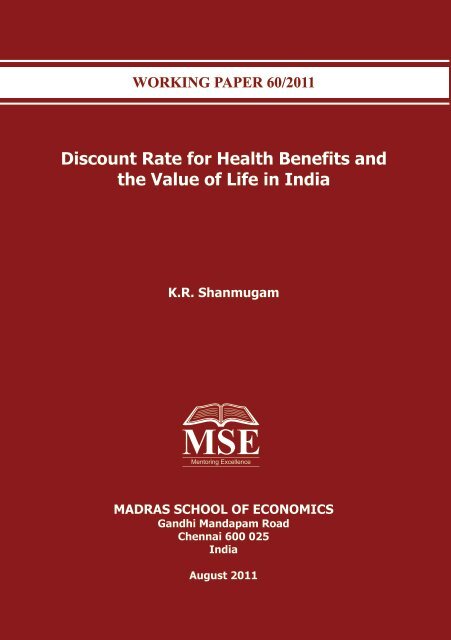
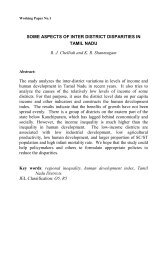
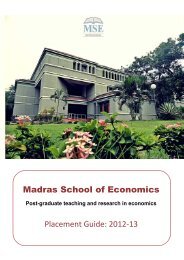
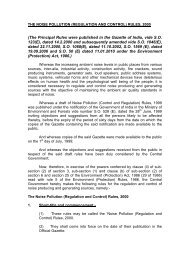
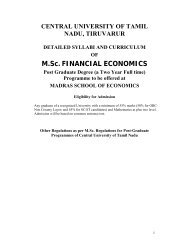
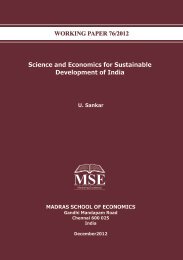
![Curriculum Vitae [pdf] - Madras School of Economics](https://img.yumpu.com/49878970/1/190x245/curriculum-vitae-pdf-madras-school-of-economics.jpg?quality=85)
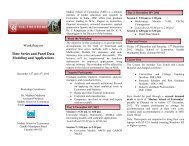
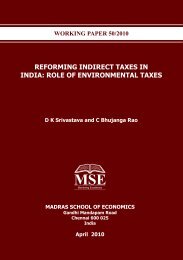
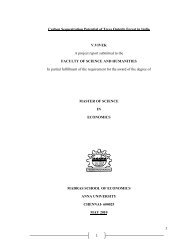
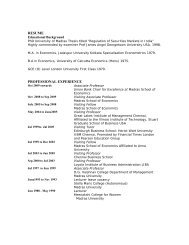
![Curriculum Vitae [pdf] - Madras School of Economics](https://img.yumpu.com/48715201/1/184x260/curriculum-vitae-pdf-madras-school-of-economics.jpg?quality=85)
